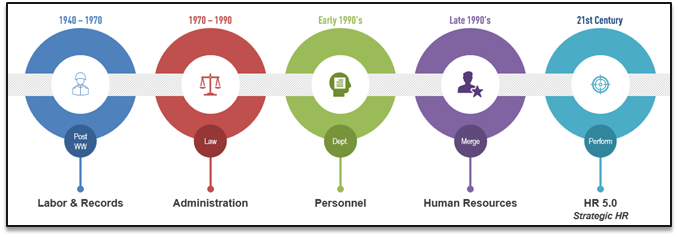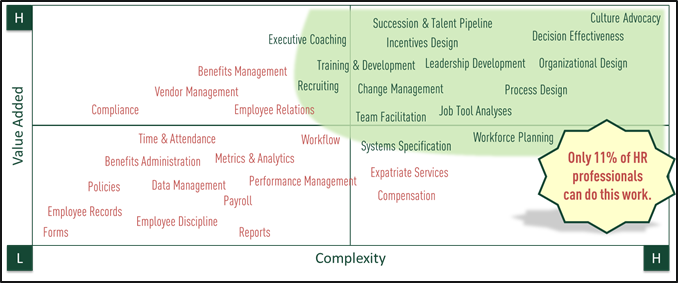HRBP – What is it?
This article examines the content of strategic human resources and the functions that the department must be able to perform. Other articles in this series include ” Strategic HR, The Business Context,” and ” Strategic HR, Undeniable ROI“
Executive Summary
Sometimes it can be a little too easy to take a term like “strategic human resources” and make the statement, ‘we don’t have that.’ After all, “Strategic HR” is (or can be) a broad reaching term. It’s worth taking some time to define what strategic human resources is and what the function, when properly setup and staffed, can provide to a business.
A Bit of History
Modern Human Resources has been through 4 major phases of development, and it’s about to go through a fifth. Therefore, in the figure below, we’ve labeled it as “HR 5.0.”

HR 1.0 Post World Wars: For the modern era, things started after the World Wars. There was quite a lot that transpired from 1940-1970. There were functions that certainly needed to be performed and work that needed to be done. These were often held as separate departments and included things such as Union Relations, Production Scheduling, Wage Management, and Worker Safety.
HR 2.0 Administration: The years 1970-1990 marked the heyday of the Corporate Administration department. Administration efforts started in the post-war/HR1.0 era, but this twenty-year period marked the years where the administration function was prevalent and common in corporate America. The American Society of Personnel Administration was founded in 1948 and gained traction in the 1970’s. Administration often included things like employee records, payroll services, policies and procedures, time management, attendance, hiring records, and termination records. The labor functions of HR1.0 were often kept separate and part of manufacturing and operations (e.g. union relations, production scheduling, and worker safety.)
HR 3.0 Personnel: During the early 1990’s the term “personnel” became en-vogue. Depending on the industry, the term was used in the late 80’s too. HR3.0 typically incorporated all the functionality of “administration” and it added things like compliance, compensation, incentives, recruiting, and employee relations. The human functions started to consolidate during this time with many organizations moving the functions of Labor Relations and Safety into the Personnel department. This terminology was short-lived though.
HR 4.0 Human Resources: The Human Resources (HR) function acquired its current title in the mid to late 1990’s. It’s hallmark in business was the intentional consolidation of all human functions that were performing in support of a business. This included capabilities such as training & development, environmental health and safety, HR information systems, organizational effectiveness, talent acquisition/recruiting, and talent management.
HR 5.0 Strategic Human Resources: That brings us to today. HR 5.0 needs to include the transactional activities that preceded it, and it needs to be built upon transactional excellence. Human Resources departments must execute the personnel and administrative transactions with mastery. Doing so allows the department the opportunity to engage in strategic human capital management. In the next couple sections, we’ll describe what strategic human resources contains.
Business FIRST
The business must come first. Fail to run an effective and profitable enterprise and it will soon cease to exist.
1. Every organization exists to take inputs and produce outputs that are consumed. Those are your products and/or services. It doesn’t matter if you’re for-profit or not-for-profit. The name of the game is: Inputs → Outputs → Consumption.
2. To grow, a business must figure out how to differentiate itself so that buyers/consumers want to consume from them versus their competitors.
3. The mix of products, services, and differentiation then drive needed human organizational capabilities. One of the better models to think about organizational capabilities is Porter’s Value Chain. Direct functions include supply chain, operations, marketing, market delivery, sales, support, and sometimes information technology. Indirect functions include human resources, finance, accounting, legal, and information technology.
The role of a strategic human resources team is to interpret business strategy into actions that change organizational capabilities which enable the achievement of the business strategy.
The Strategic HR Function
A picture is worth a lot of words in this case, and the figure below helps to illustrate the area where the strategic HR function must evolve.

The super-important point to make about the figure above is that what’s needed isn’t a movement from bottom-left to top-right. What’s needed is everything on the chart! What’s needed is “all of the above.” The challenge to both business and educators is that we need to prepare human resources professionals to be competent in the highly complex and highly valuable skills. Only 11% of HR professionals are proficient today.
This is why we partnered with one of the country’s leading business schools, The University of Texas at Dallas to develop a Strategic Human Resources program. This program directly addresses these skill gaps and prepares HR professionals to “KEEP their SEAT at the Table.” It is our aim to make the Chief HR Officer and the Chief People Officer the default successor to the CEO role. In the famous words of Patrick Lencioni, “Not Finance. Not Strategy. Not Technology. It is teamwork that remains the ultimate competitive advantage, both because it is so powerful and so rare” [emphasis mine].
Recommended Citation:
Albrecht, D.J. (2021). Strategic HR Definition (Article). Dallas, TX: Alonos Corporation. Retrieved from: Alonos.com
About the Author
Dr. Dale J. Albrecht is Principal Consultant in Human Resources and Leadership for Alonos. He is the author of “Organizational Design that Sticks!” and “DECIDE to Thrive.” He is also an Adjunct Professor for both The University of Texas at Dallas and Texas Woman’s University.
Dr. Albrecht has fulfilled executive leadership roles in Human Resources, Consulting, and Organizational Development. He also has significant career experience in project management, engineering, technical operations, and workforce education. He has worked in several industries including retail, manufacturing, telecommunications, medical devices, construction, and Department of Defense. He has considerable experience consulting with most corporate functional areas including supply chain, engineering, software development, sales, marketing, human resources, information technology, and service/support.

